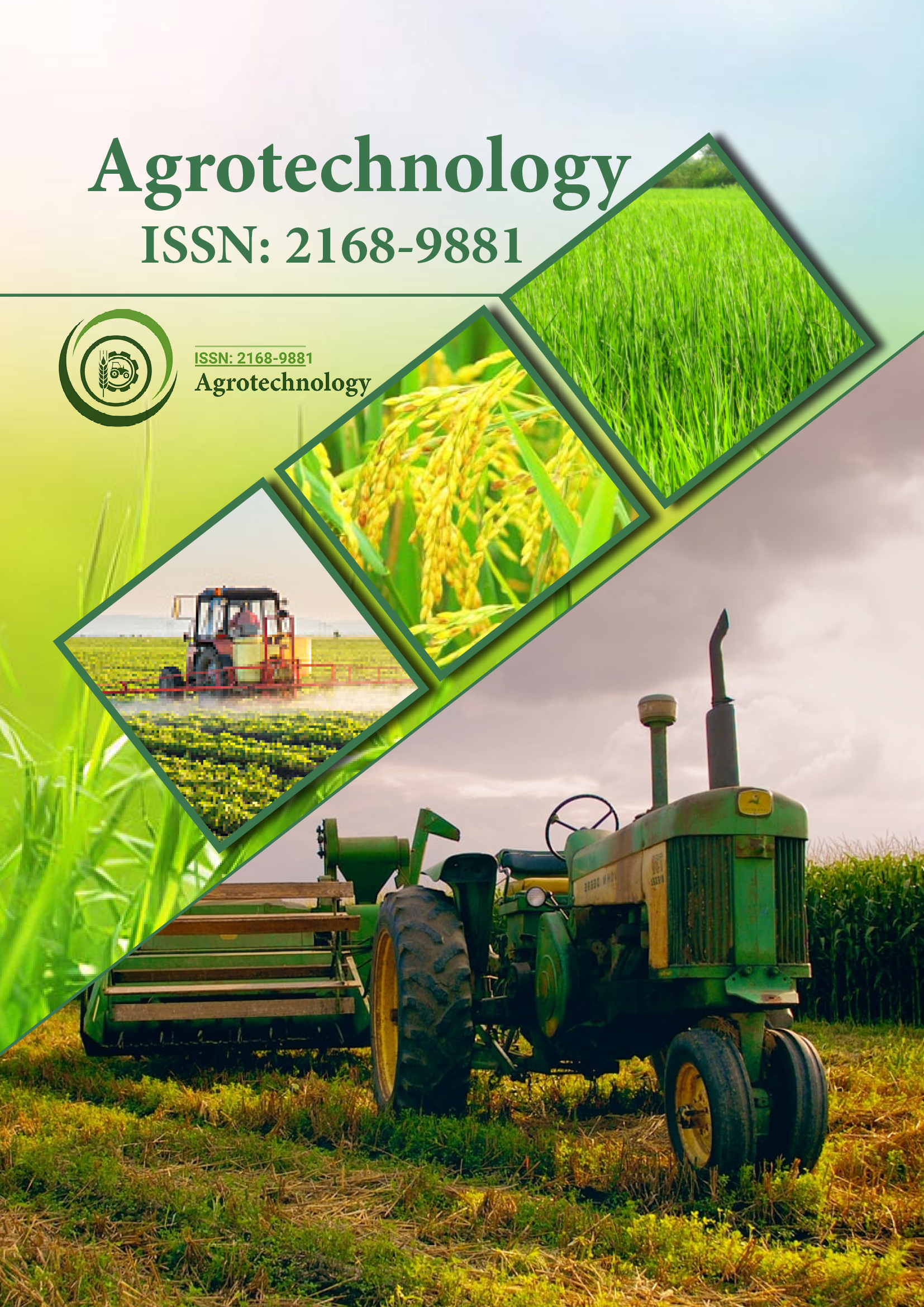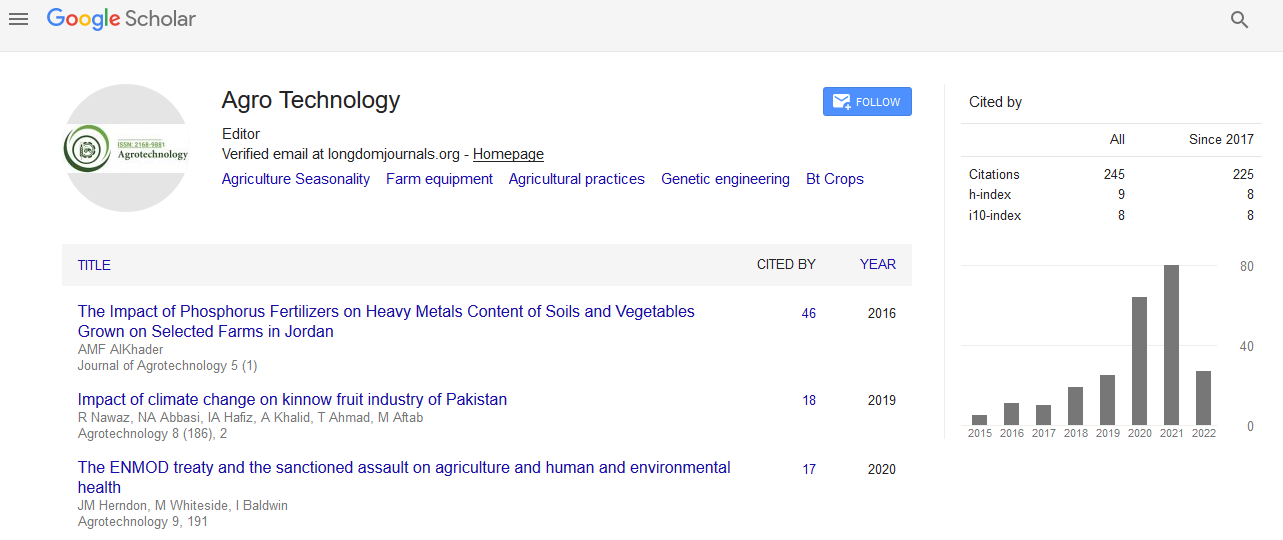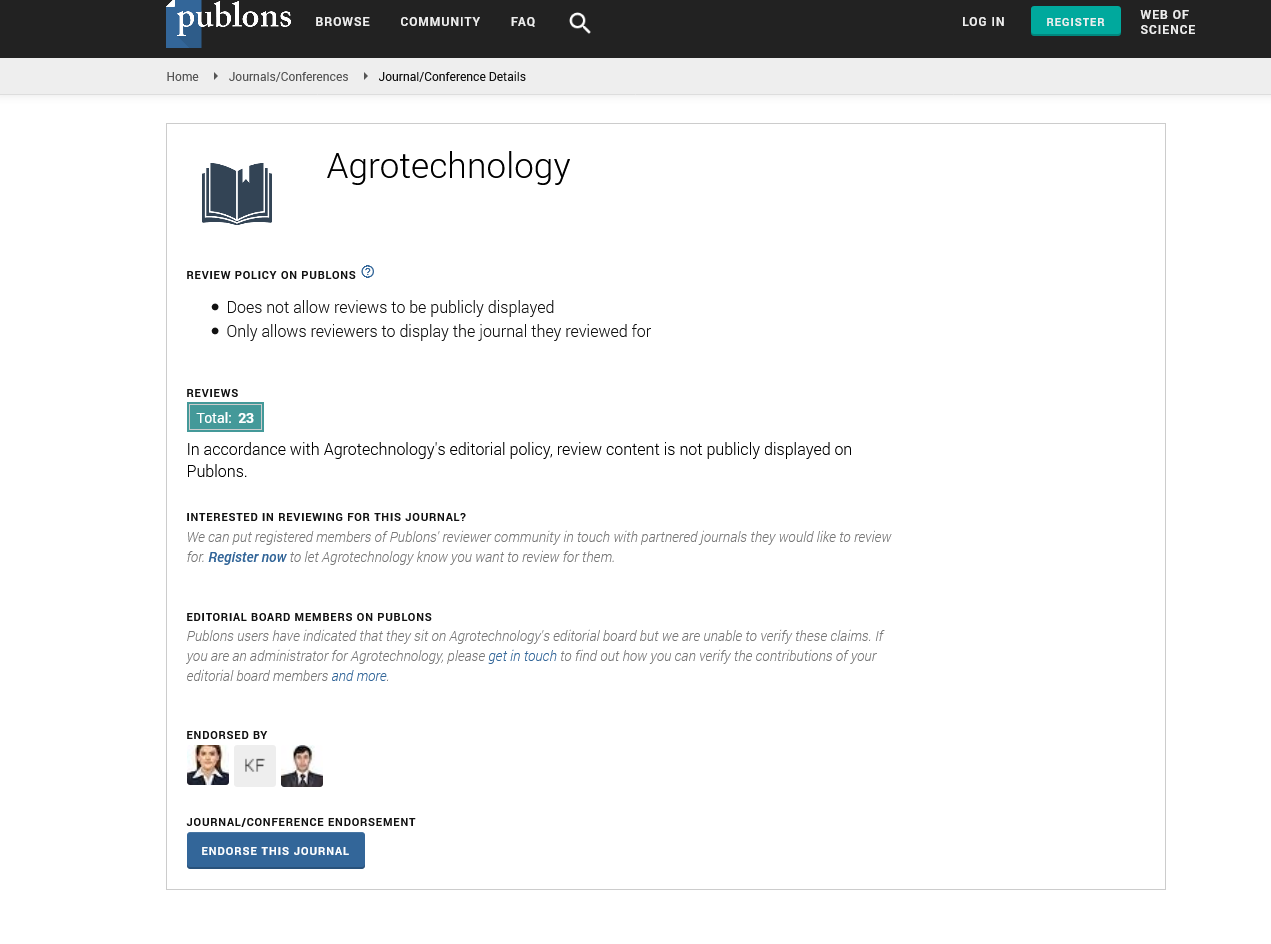Indexed In
- Open J Gate
- Genamics JournalSeek
- Academic Keys
- ResearchBible
- Cosmos IF
- Access to Global Online Research in Agriculture (AGORA)
- Electronic Journals Library
- RefSeek
- Directory of Research Journal Indexing (DRJI)
- Hamdard University
- EBSCO A-Z
- OCLC- WorldCat
- Scholarsteer
- SWB online catalog
- Virtual Library of Biology (vifabio)
- Publons
- Geneva Foundation for Medical Education and Research
- Euro Pub
- Google Scholar
Useful Links
Share This Page
Journal Flyer

Open Access Journals
- Agri and Aquaculture
- Biochemistry
- Bioinformatics & Systems Biology
- Business & Management
- Chemistry
- Clinical Sciences
- Engineering
- Food & Nutrition
- General Science
- Genetics & Molecular Biology
- Immunology & Microbiology
- Medical Sciences
- Neuroscience & Psychology
- Nursing & Health Care
- Pharmaceutical Sciences
Short Communication - (2025) Volume 14, Issue 1
Sustainable Protein Production from Wheatgrass in Vertical Farming Systems
Noah Park*Received: 19-Feb-2025, Manuscript No. AGT-25-28743; Editor assigned: 21-Feb-2025, Pre QC No. AGT-25-28743 (PQ); Reviewed: 07-Mar-2025, QC No. AGT-25-28743; Revised: 14-Mar-2025, Manuscript No. AGT-25-28743 (R); Published: 21-Mar-2025, DOI: 10.35248/2168-9891.25.14.398
Description
The increasing demand for sustainable and nutrient-rich food sources has driven interest in alternative protein production systems that offer both environmental and nutritional benefits. Wheatgrass, known for its high chlorophyll and micronutrient content, is now being explored for its protein yield, especially in controlled-environment agriculture such as vertical farming systems. A Life Cycle Assessment (LCA) of protein production from wheatgrass within a novel vertical farming setup reveals potential optimization potential in terms of environmental impact, energy use and yield efficiency [1].
In this analysis, a vertical farming unit specifically engineered for wheatgrass cultivation was evaluated using a cradle-to-harvest LCA framework [2]. The assessment included inputs such as energy consumption for lighting, water usage, nutrient solutions, growth substrates, climate control systems and labor, as well as outputs such as biomass yield, protein content and waste streams. The study focused on protein production efficiency per square meter and per kilogram of harvested wheatgrass powder, a key metric for assessing its viability compared to conventional protein sources.
Preliminary findings indicated that vertical farming of wheatgrass under optimized conditions can result in a protein yield of approximately 2.8 kg per square meter annually [3]. This is achieved through a rapid growth cycle of 7-10 days per harvest and the ability to cultivate year-round using stacked layers. However, the environmental footprint, especially in terms of electricity used for LED lighting and HVAC systems, constitutes the majority of the system's total energy consumption. These factors alone account for over 65% of the system’s greenhouse gas emissions in COâ?? equivalents per functional unit [4].
Fundamental areas of optimization identified include dynamic lighting schedules, integration of renewable energy sources and automation of nutrient delivery. By using spectrum-adjusted LEDs that target photosynthetically active radiation more efficiently, electricity consumption could be reduced by 25%-30% without compromising yield. Similarly, implementing closed-loop water recirculation systems and automating fertigation schedules can significantly reduce water and nutrient input while maintaining consistent protein output. -derived nutrient Substituting traditional synthetic nutrient mixes with organic or waste sources could further improve the sustainability profile of the production system [5].
The protein extracted from wheatgrass in this system was characterized by a favorable amino acid profile, particularly rich in lysine and threonine, which are often limiting in plant-based diets [6]. Compared to soybean protein, the wheatgrass protein required nearly 40% less water per gram of protein produced, albeit with a slightly higher energy input. These trade-offs suggest that while vertical wheatgrass farming may not yet surpass traditional crops in all LCA categories, its scalability, urban proximity and year-round production capacity present compelling advantages.
An interesting aspect of this novel vertical system is its modularity, allowing it to be deployed in both rural and urban settings with minimal land use. The compact design ensures that systems can be stacked vertically in underutilized urban spaces, bringing protein production closer to consumers and reducing emissions associated with transportation and cold-chain logistics [7]. This localization aligns with sustainable food system goals and supports the resilience of protein supply chains in the face of climate disruptions.
Further integration of real-time sensor networks and AI-driven crop monitoring can enhance productivity and reduce resource waste. Predictive analytics could be used to forecast protein content and growth rates based on environmental conditions, enabling precise control of inputs and harvesting schedules [8]. Such data-driven optimizations not only improve the economic feasibility of vertical wheatgrass farming but also support transparent and traceable supply chains for functional food and supplement markets.
While this study presents encouraging data, limitations remain. The initial capital cost of setting up the vertical farming infrastructure, especially for small-scale growers, can be prohibitive [9]. Furthermore, consumer awareness and market demand for wheatgrass protein beyond niche health-conscious communities need to be addressed. Policy support, investment in green energy integration and further research into crop genomics and agronomic traits of wheatgrass could help overcome these barriers [10].
Conclusion
In conclusion, the life cycle assessment of protein production from wheatgrass in a novel vertical farming system demonstrates that with targeted technological optimizations, it is possible to achieve a low-footprint, high-yield alternative protein source. Although the system still relies heavily on energy inputs, especially during early implementation stages, advances in energy efficiency and integration of sustainable practices indicate strong potential for scalability. As urban agriculture continues to evolve, wheatgrass protein farming stands as a viable contributor to future food security and sustainable nutrition strategies.
References
- Wu Z, Maga D, Aryan V, Reimann A, Safarpour T, Schillberg S. A life cycle assessment of protein production from wheatgrass: Optimization potential of a novel vertical farming system. Sustain Prod Consum. 2024;51:105-17.
- Touliatos D, Dodd IC, McAinsh M. Vertical farming increases lettuce yield per unit area compared to conventional horizontal hydroponics. Food Energy Secur. 2016;5(3):184-91.
[Crossref] [Google Scholar] [PubMed]
- Kernbach S. Biofeedback-based closed-loop Phytoactuation in vertical farming and controlled-environment agriculture. Biomimetics. 2024;9(10):640.
[Crossref] [Google Scholar] [PubMed]
- Quinton CD, Hely FS, Amer PR, Byrne TJ, Cromie AR. Prediction of effects of beef selection indexes on greenhouse gas emissions. Animal. 2018;12(5):889-897.
[Crossref] [Google Scholar] [PubMed]
- Kuang ZY, Yang H, Shen SW, Lin YN, Sun SW, Neureiter M, et al. Bio-conversion of organic wastes towards polyhydroxyalkanoates. Biotechnology Notes. 2023;4:118-26.
[Crossref] [Google Scholar] [PubMed]
- Herpich C, Müller-Werdan U, Norman K. Role of plant-based diets in promoting health and longevity. Maturitas. 2022;165:47-51.
[Crossref] [Google Scholar] [PubMed]
- Rathor AS, Choudhury S, Sharma A, Nautiyal P, Shah G. Empowering vertical farming through IoT and AI-Driven technologies: A comprehensive review. Heliyon. 2024;10(15):e34998.
[Crossref] [Google Scholar] [PubMed]
- Zhang D, Xu F, Wang F, Le L, Pu L. Synthetic biology and artificial intelligence in crop improvement. Plant Commun. 2024.
[Crossref] [Google Scholar] [PubMed]
- Morella P, Lambán MP, Royo J, Sánchez JC. Vertical farming monitoring: How does it work and how much does it cost? Sensors. 2023;23(7):3502.
[Crossref] [Google Scholar] [PubMed]
- Kumar S, Darshna A, Ranjan D. A review of literature on the integration of green energy and circular economy. Heliyon. 2023;9(11):e21091.
[Crossref] [Google Scholar] [PubMed]
Citation: Park N (2025) Sustainable Protein Production from Wheatgrass in Vertical Farming Systems. Agrotechnology. 14:398.
Copyright: © 2025 Park N. This is an open access article distributed under the terms of the Creative Commons Attribution License, which permits unrestricted use, distribution, and reproduction in any medium, provided the original author and source are credited.


